
Adolfo Farsari
Encyclopedia
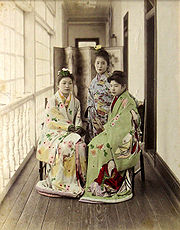
Italy
Italy , officially the Italian Republic languages]] under the European Charter for Regional or Minority Languages. In each of these, Italy's official name is as follows:;;;;;;;;), is a unitary parliamentary republic in South-Central Europe. To the north it borders France, Switzerland, Austria and...
photographer
Photography
Photography is the art, science and practice of creating durable images by recording light or other electromagnetic radiation, either electronically by means of an image sensor or chemically by means of a light-sensitive material such as photographic film...
based in Yokohama
Yokohama
is the capital city of Kanagawa Prefecture and the second largest city in Japan by population after Tokyo and most populous municipality of Japan. It lies on Tokyo Bay, south of Tokyo, in the Kantō region of the main island of Honshu...
, Japan
Japan
Japan is an island nation in East Asia. Located in the Pacific Ocean, it lies to the east of the Sea of Japan, China, North Korea, South Korea and Russia, stretching from the Sea of Okhotsk in the north to the East China Sea and Taiwan in the south...
. Following a brief military career, including service in the American Civil War
American Civil War
The American Civil War was a civil war fought in the United States of America. In response to the election of Abraham Lincoln as President of the United States, 11 southern slave states declared their secession from the United States and formed the Confederate States of America ; the other 25...
, he became a successful entrepreneur
Entrepreneur
An entrepreneur is an owner or manager of a business enterprise who makes money through risk and initiative.The term was originally a loanword from French and was first defined by the Irish-French economist Richard Cantillon. Entrepreneur in English is a term applied to a person who is willing to...
and commercial photographer. His photographic work was highly regarded, particularly his hand-coloured
Hand-colouring
Hand-colouring refers to any method of manually adding colour to a black-and-white photograph, generally either to heighten the realism of the photograph or for artistic purposes...
portraits and landscapes, which he sold mostly to foreign residents and visitors to the country. Farsari's images were widely distributed, presented or mentioned in books and periodicals, and sometimes recreated by artists in other media; they shaped foreign perceptions of the people and places of Japan and to some degree affected how Japanese saw themselves and their country. His studio
Photographic studio
A photographic studio is both a workspace and a corporate body. As a workspace it is much like an artist’s studio, but providing space to take, develop, print and duplicate photographs. Photographic training and the display of finished photographs may also be accommodated in a photographic studio...
, the last notable foreign-owned studio in Japan, was one of the country's largest and most prolific commercial photographic firms. Largely due to Farsari's exacting technical standards and his entrepreneurial abilities it had a significant influence on the development of photography in Japan.
Early years
Adolfo Farsari was born in VicenzaVicenza
Vicenza , a city in north-eastern Italy, is the capital of the eponymous province in the Veneto region, at the northern base of the Monte Berico, straddling the Bacchiglione...
, Lombardy-Venetia (then part of the Austrian Empire
Austrian Empire
The Austrian Empire was a modern era successor empire, which was centered on what is today's Austria and which officially lasted from 1804 to 1867. It was followed by the Empire of Austria-Hungary, whose proclamation was a diplomatic move that elevated Hungary's status within the Austrian Empire...
, now in Italy). He began a career in the Italian military in 1859 but emigrated to the United States
United States
The United States of America is a federal constitutional republic comprising fifty states and a federal district...
in 1863 and, a fervent abolitionist, Farsari served with the Union Army
Union Army
The Union Army was the land force that fought for the Union during the American Civil War. It was also known as the Federal Army, the U.S. Army, the Northern Army and the National Army...
as a New York State Volunteer Cavalry trooper until the end of the American Civil War
American Civil War
The American Civil War was a civil war fought in the United States of America. In response to the election of Abraham Lincoln as President of the United States, 11 southern slave states declared their secession from the United States and formed the Confederate States of America ; the other 25...
. He married an American, but the marriage failed and in 1873 he left his wife and two children and moved to Japan.
Based in Yokohama, Farsari formed a partnership with E.A. Sargent. Their firm, Sargent, Farsari & Co., dealt in smokers' supplies, stationery, visiting cards, newspapers, magazines and novels, Japanese and English conversation books, dictionaries, guidebooks, maps, and photographic views of Japan. The creator of these photographs remains unknown, but Farsari was the maker of at least some of the maps, notably of Miyanoshita
Miyanoshita Onsen
is an onsen in the town of Hakone, Kanagawa Prefecture, Japan. The hot springs have been an attraction for tourists and pleasure-seekers for hundreds of years going back to the beginning of the Edo period. The town is situated on a plateau in the Hayakawa River valley. Miyanoshita is one of the...
(in the Hakone
Hakone, Kanagawa
is a town in Ashigarashimo District in Kanagawa Prefecture, Japan. As of 2010, the town had an estimated population of 13,339 and a density of 144 persons per km². The total area was 92.82 km².-Geography:...
resort area) and Yokohama. After his partnership with Sargent ended, the company, now A. Farsari & Co., published successive editions of Keeling's Guide to Japan
Keeling's Guide to Japan
Keeling's Guide to Japan was a tourist guidebook published in several editions during the 19th century by the Yokohama-based firm, A. Farsari & Co. The guidebook provided accurate and detailed maps and plans of Japanese cities, resort areas, and building complexes; descriptions of sites, services...
and Farsari himself wrote and published Japanese Words and Phrases for the Use of Strangers. The firm was among the most prolific publishers of materials to aid travellers, having produced its first guidebook to Japan by July 1880.
Photographic career and studio
Farsari expanded his business interests into commercial photography and taught himself photography in 1883. In 1885 he formed a partnership with photographer Tamamura KozaburōTamamura Kozaburo
Tamamura Kozaburō was a Japanese photographer. In 1874 he opened a photographic studio in Asakusa, Tokyo and subsequently moved to Yokohama in 1883, opening his most successful studio. He was an originator of the Yokohama shashin photographic scene. His studio was still operating in...
to acquire the Stillfried & Andersen
Stillfried & Andersen
The firm of Stillfried & Andersen, also known as the Japan Photographic Association, was a photographic studio founded by Baron Raimund von Stillfried and Hermann Andersen that operated in Yokohama, Japan between 1876 and 1885. The studio is noted for its fine portraits and landscapes that were...
studio (also known as the Japan Photographic Association), which had some 15 Japanese employees. The studio's stock included images by Felice Beato
Felice Beato
Felice Beato , also known as Felix Beato, was an Italian–British photographer. He was one of the first people to take photographs in East Asia and one of the first war photographers. He is noted for his genre works, portraits, and views and panoramas of the architecture and landscapes of Asia and...
that it had acquired along with Beato's studio in 1877. It is not clear how long the partnership of Tamamura and Farsari lasted, for within a few years they were in competition with each other. Farsari further expanded his business in 1885 when the Yokohama Photographic Company (owned by David Welsh) folded and Farsari acquired its premises (next door to his own) and moved in. In addition to his Yokohama studio, Farsari likely had agents in Kobe
Kobe
, pronounced , is the fifth-largest city in Japan and is the capital city of Hyōgo Prefecture on the southern side of the main island of Honshū, approximately west of Osaka...
and Nagasaki. By the end of 1886, Farsari and Chinese photographer Tong Cheong
Tong Cheong
Tong Cheong was a Chinese photographer who operated in Yokohama, Japan in the 19th century. Cheong advertised his services as a printer and photographer in the 1884 Japan Directory, offering souvenir albums of the "views and costumes" of Japan...
were the only foreign commercial photographers still operating in Japan, and by the following year even Tong Cheong had gone.
In February 1886 a fire destroyed all of Farsari's negatives
Negative (photography)
In photography, a negative may refer to three different things, although they are all related.-A negative:Film for 35 mm cameras comes in long narrow strips of chemical-coated plastic or cellulose acetate. As each image is captured by the camera onto the film strip, the film strip advances so that...
, and he then toured Japan for five months taking new photographs to replace them. He reopened his studio in 1887. Despite his losses in the fire, by 1889 Farsari's stock comprised about 1,000 Japanese landscapes and genre portraits.
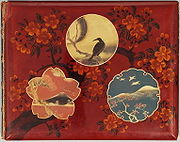
Felice Beato
Felice Beato , also known as Felix Beato, was an Italian–British photographer. He was one of the first people to take photographs in East Asia and one of the first war photographers. He is noted for his genre works, portraits, and views and panoramas of the architecture and landscapes of Asia and...
and Baron Raimund von Stillfried
Baron Raimund von Stillfried
Baron Raimund von Stillfried, also known as Baron Raimund von Stillfried-Rathenitz , was an Austrian photographer.He was a son of August Wilhelm Freiherr Stillfried von Rathenitz Baron Raimund von Stillfried, also known as Baron Raimund von Stillfried-Rathenitz (6 August 1839, Komotau – 12...
, Farsari further developed the trade in photograph albums. His studio generally produced sepia monochrome albumen print
Albumen print
The albumen print, also called albumen silver print, was invented in 1850 by Louis Désiré Blanquart-Evrard, and was the first commercially exploitable method of producing a photographic print on a paper base from a negative...
s that were hand-coloured
Hand-colouring
Hand-colouring refers to any method of manually adding colour to a black-and-white photograph, generally either to heighten the realism of the photograph or for artistic purposes...
and mounted on album leaves. These pages were often hand decorated and bound between covers of silk brocade or lacquer boards inlaid with ivory, mother-of-pearl and gold. Like his contemporaries, Farsari usually captioned and numbered his photographs in the images, often in white lettering on a black background.
Farsari sold many of these photograph albums, particularly to foreign residents and visitors. He employed excellent artists who each produced high-quality work at a pace of two or three hand-coloured prints per day. Farsari ensured that the colours were true to life and that the best materials were used. Accordingly, his work was expensive, yet popular and often praised by clients and visitors to Japan, even receiving a glowing reference by Rudyard Kipling
Rudyard Kipling
Joseph Rudyard Kipling was an English poet, short-story writer, and novelist chiefly remembered for his celebration of British imperialism, tales and poems of British soldiers in India, and his tales for children. Kipling received the 1907 Nobel Prize for Literature...
following his 1889 visit to Yokohama. That same year, Farsari presented a deluxe photograph album to the King of Italy
King of Italy
King of Italy is a title adopted by many rulers of the Italian peninsula after the fall of the Roman Empire...
. By the 1890s, the studio's high reputation earned it exclusive rights to photograph the Imperial Gardens in Tokyo
Tokyo
, ; officially , is one of the 47 prefectures of Japan. Tokyo is the capital of Japan, the center of the Greater Tokyo Area, and the largest metropolitan area of Japan. It is the seat of the Japanese government and the Imperial Palace, and the home of the Japanese Imperial Family...
.
Prospective colourists at A. Farsari & Co. were interviewed by Farsari himself, who ensured they were familiar with Japanese painting
Japanese painting
is one of the oldest and most highly refined of the Japanese visual arts, encompassing a wide variety of genres and styles. As with the history of Japanese arts in general, the long history of Japanese painting exhibits synthesis and competition between native Japanese aesthetics and adaptation of...
techniques. Once hired, they were given unpaid instruction for several months, and then a basic salary that steadily increased as Farsari became satisfied with their work. A capable and loyal colourist could earn twice the rate offered at other Yokohama studios and double his own daily rate for work on Sundays. Colourists also received regular bonuses and gifts. On the other hand, Farsari complained in a letter to his sister that to motivate his employees he had to rage, swear and beat them, which he did according to a fixed schedule. By 1891 A. Farsari & Co. had 32 employees, 19 of whom were hand-colouring artists.
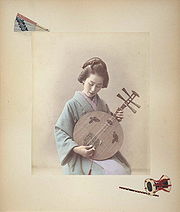
Knight
A knight was a member of a class of lower nobility in the High Middle Ages.By the Late Middle Ages, the rank had become associated with the ideals of chivalry, a code of conduct for the perfect courtly Christian warrior....
and thereby join the Italian aristocracy
Aristocracy
Aristocracy , is a form of government in which a few elite citizens rule. The term derives from the Greek aristokratia, meaning "rule of the best". In origin in Ancient Greece, it was conceived of as rule by the best qualified citizens, and contrasted with monarchy...
. His success in these endeavours is not clear. Nevertheless, in April 1890 he and his daughter left Japan for Italy. On 7 February 1898 Farsari died in his family home in Vicenza
Vicenza
Vicenza , a city in north-eastern Italy, is the capital of the eponymous province in the Veneto region, at the northern base of the Monte Berico, straddling the Bacchiglione...
.
Following Farsari's departure from Japan in 1890, his studio continued to operate and even listed him as proprietor until 1901, when Tonokura Tsunetarō
Tonokura Tsunetaro
was the owner of the A. Farsari & Co. photographic studio, based in Yokohama, Japan. Tonokura, who had known the firm's founder Adolfo Farsari since the 1870s, managed the firm's day-to-day affairs until he became its owner in 1901. He left the company in 1904 to start his own...
became the owner. Tonokura, whom Farsari had known since the mid-1870s, had long managed the day-to-day operations of the studio. In 1904 Tonokura left the business to start his own studio and another of Farsari's former employees, Watanabe Tokutarō
Watanabe Tokutaro
Watanabe Tokutarō was the owner of the A. Farsari & Co. photographic studio. Watanabe initially was the firm's chief operator under the ownership by Adolfo Farsari and then Tonokura Tsunetarō. Following the departure of Tonokura in 1904, Watanabe became the new owner, only to be succeeded by the...
, became the new owner, only to be succeeded by the former secretary, Fukagawa Itomaro
Fukagawa Itomaro
Fukagawa Itomaro was the secretary and owner of the A. Farsari & Co. photographic studio. Following the departure of Watanabe Tokutarō in 1904 or shortly thereafter, Fukagawa became the new owner. A. Farsari & Co. was based in Yokohama, Japan.-References:...
. The business was finally registered as a Japanese company in 1906 and it continued to operate until at least 1917 and possibly as late as 1923, the year in which Yokohama was largely destroyed by the Great Kantō Earthquake
1923 Great Kanto earthquake
The struck the Kantō plain on the Japanese main island of Honshū at 11:58:44 am JST on September 1, 1923. Varied accounts hold that the duration of the earthquake was between 4 and 10 minutes...
. A. Farsari & Co. was the last notable foreign-owned photographic studio to operate in Japan.
Farsari and Yokohama shashin
Farsari expressed his view of photography in a letter to his sister, writing, "taking pictures is just a mechanical thing." In describing his development as a photographer, he wrote, "I have had no real teachers, I have learned everything from books. I bought all the necessary equipment and with no help from anyone, I printed, took photographs and so on. Then I taught others."Of course, Farsari did not work in isolation. The works (particularly those that were hand-coloured) and practices of the many foreign and Japanese commercial photographers who operated in Yokohama from the 1860s to the 1880s have been termed Yokohama shashin (literally, "Yokohama photographs" or "photography"). Farsari and its other practitioners – notably Beato, Stillfried, Tamamura, Kusakabe Kimbei
Kusakabe Kimbei
Kusakabe Kimbei was a Japanese photographer. He usually went by his given name, Kimbei, because his clientele, mostly non-Japanese-speaking foreign residents and visitors, found it easier to pronounce than his family name....
, Ogawa Kazumasa
Ogawa Kazumasa
, also known as Ogawa Kazuma or Ogawa Isshin, was a Japanese photographer, printer and publisher who was a pioneer in photomechanical printing and photography in the Meiji era.Ogawa was born in Saitama to the Matsudaira samurai clan...
, and Uchida Kuichi
Uchida Kuichi
was a pioneering Japanese photographer from Nagasaki. He was greatly respected as a portrait photographer and was the only photographer granted a sitting to photograph the Emperor Meiji....
– produced works that in their subject matter, composition and colouring present a striking combination of the conventions and techniques of Western photography with those of Japanese artistic traditions, particularly ukiyo-e
Ukiyo-e
' is a genre of Japanese woodblock prints and paintings produced between the 17th and the 20th centuries, featuring motifs of landscapes, tales from history, the theatre, and pleasure quarters...
. These photographers also provided the key images by which Meiji-era
Meiji period
The , also known as the Meiji era, is a Japanese era which extended from September 1868 through July 1912. This period represents the first half of the Empire of Japan.- Meiji Restoration and the emperor :...
Japan and the Japanese were known to people in other countries. Interestingly, their images also changed the ways in which Japanese saw their own country. Through their images, foreign photographers publicised sites that interested them, sometimes drawing Japanese attention to hitherto neglected locations. One was the now-important "Daibutsu" (great Buddha) at Kōtoku-in
Kotoku-in
is a Buddhist temple of the Jōdo-shū sect in the city of Kamakura in Kanagawa Prefecture, Japan.The temple is renowned for its , a monumental outdoor bronze statue of Amida Buddha which is one of the most famous icons of Japan.- The Great Buddha :...
, Kamakura
Kamakura, Kanagawa
is a city located in Kanagawa Prefecture, Japan, about south-south-west of Tokyo. It used to be also called .Although Kamakura proper is today rather small, it is often described in history books as a former de facto capital of Japan as the seat of the Shogunate and of the Regency during the...
. In a similar vein, Farsari's and others' photographs of the mausoleums of Tōshō-gū made the once restricted site familiar to a wider audience.

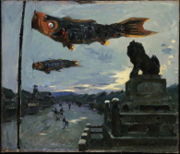
Ryo (currency)
A was a gold piece in pre-Meiji Japan. It was worth about sixty monme of silver or four kan of copper . It was eventually replaced with a system based on the yen....
“per head”, about a month's pay for an artisan. Given such pricing, few Japanese could afford photographs and a photographer's clientele was largely drawn from the foreign residents of the European and American enclaves: colonial administrators, missionaries, merchants and the military. By the early 1870s, tourists had joined their number. To appeal to this clientele, photographers often staged and contrived the scenes they photographed, particularly the portraits depicting “manners and customs”.
In 1885, Charles J. S. Makin used some of Farsari's views to illustrate his travel account Land of the Rising Sun, Being a Short Account of Japan and the Japanese. As photomechanical printing was still in its infancy, it was common for artists and illustrators to create works derived from photographs. For example, Charles Wirgman
Charles Wirgman
Charles Wirgman was an English artist and cartoonist, the creator of the Japan Punch and illustrator in China and Meiji period Japan for the Illustrated London News....
's numerous engravings for the Illustrated London News
Illustrated London News
The Illustrated London News was the world's first illustrated weekly newspaper; the first issue appeared on Saturday 14 May 1842. It was published weekly until 1971 and then increasingly less frequently until publication ceased in 2003.-History:...
were made from views by Wirgman's friend and sometime partner Felice Beato. Occasionally the link between a work of art and its photographic source material was less overt: Louis-Jules Dumoulin's
Louis-Jules Dumoulin
Louis-Jules Dumoulin was a French artist and painter. He was born in Paris.-References:* . Accessed 10 December 2006.* . Accessed 10 December 2006....
1888 oil painting Boys' Festival from the Bluff, Yokohama [sic] (now called Carp Banners in Kyoto) draws heavily from Farsari's photograph Gionmachi, Kioto (now often called View of Shijō-dōri, Kyoto); although the painted image strongly resembles the photographic source, the location of the subject has been changed in the title.
During the era of the collodion process
Collodion process
The collodion process is an early photographic process. It was introduced in the 1850s and by the end of that decade it had almost entirely replaced the first practical photographic process, the daguerreotype. During the 1880s the collodion process, in turn, was largely replaced by gelatin dry...
, before the arrival of less demanding photographic technology (the gelatin silver process
Gelatin-silver process
The gelatin silver process is the photographic process used with currently available black-and-white films and printing papers. A suspension of silver salts in gelatin is coated onto a support such as glass, flexible plastic or film, baryta paper, or resin-coated paper...
, photographic film
Photographic film
Photographic film is a sheet of plastic coated with an emulsion containing light-sensitive silver halide salts with variable crystal sizes that determine the sensitivity, contrast and resolution of the film...
, and smaller cameras) and the consequent rise of amateur photography, commercial photographers like Farsari had a particular importance for recording events and views. In Japan before 1899 such photographers were even more significant because the government required foreigners to obtain passes to journey to the interior, and commercial photographers based in Japan could more easily gain access and provide rare images of restricted areas. By 1889, however, Farsari estimated that about half of all visitors to Yokohama
Yokohama
is the capital city of Kanagawa Prefecture and the second largest city in Japan by population after Tokyo and most populous municipality of Japan. It lies on Tokyo Bay, south of Tokyo, in the Kantō region of the main island of Honshu...
were amateur photographers; even if this was an exaggeration, the presence of increasing numbers of amateur photographers was obviously having an impact on the commercial photography business. To encourage amateur photographers to visit his studio and possibly buy his merchandise, Farsari provided free use of a darkroom.

The lifetime of A. Farsari & Co. spanned the transition of Japanese photography from the early involvement and influence of foreign photographers to the emergence of an independent, native Japanese photographic identity. Coming after the first generation of photographers, the firm made significant contributions to the development of commercial photography in Japan by emphasising the excellence of materials, refining the practice of presenting photographs in albums (which became art objects in themselves), and making effective use of Farsari's own tourist-oriented publications to promote his photographic studio's work – an early, minor example of vertical integration
Vertical integration
In microeconomics and management, the term vertical integration describes a style of management control. Vertically integrated companies in a supply chain are united through a common owner. Usually each member of the supply chain produces a different product or service, and the products combine to...
.
Evaluations of his work
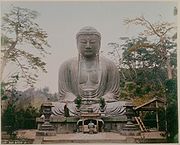
W. K. Burton
William Kinnimond Burton was a British engineer, photographer and photography writer, born in Edinburgh, Scotland, who lived most of his career in Meiji period Japan.-Early life:...
published an appraisal in an 1887 article: "I have seen no better work in the way of coloured photographs anywhere than some of Farsari's productions". In the same year, an admiring review of Farsari's work appeared in the journal Photographic Times and American Photographer, describing it as "technically almost perfect" and showing "artistic proportion" in the selection of subjects, depicting Japanese life and providing images of the natural beauty of a country that was admittedly unfamiliar to Americans.
Later opinions have been divided. In a 1988 article, art and photography historian Ellen Handy described A. Farsari & Co. as having become "well-known for issuing albums of landscape views in great quantity, but without regard for print quality and delicacy of hand-colouring". Terry Bennett, a specialist in the early photography of Asia, refers to Farsari's work as "inconsistent and lacking the quality found in the photography of Beato, Stillfried or Kusakabe." But Bennett also notes that Farsari employed excellent artists, used the best paper and produced some "stunningly coloured photographs". For historian Sebastian Dobson, the artistic and historical significance of the work of Farsari (and other Yokohama photographers of his era, particularly Kusakabe and Tamamura) is rightly undergoing re-evaluation after many years in which it was dismissed as tourist kitsch
Kitsch
Kitsch is a form of art that is considered an inferior, tasteless copy of an extant style of art or a worthless imitation of art of recognized value. The concept is associated with the deliberate use of elements that may be thought of as cultural icons while making cheap mass-produced objects that...
and "perceived by some as pandering to nineteenth-century Western notions of exoticism". Farsari's photographs and albums are included in numerous museums and private collections around the world, and a selection of his works was exhibited at the Museum of Fine Arts, Boston in 2004.

